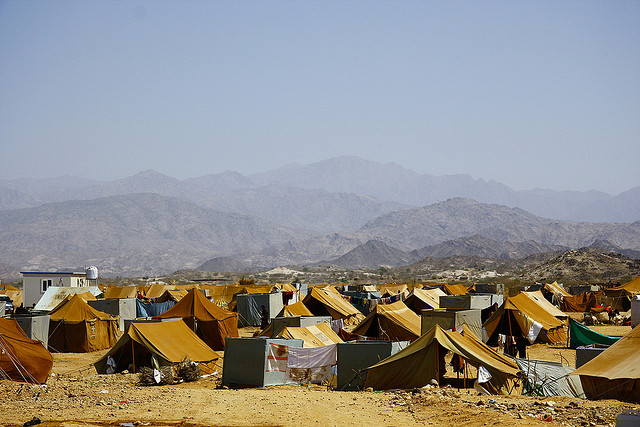In early 2010, Sheikh ‘Abd Al-Majid Al-Zindani, then a US government-designated terrorist by virtue of his support for al-Qaeda, convened a meeting of Yemeni activists to urge national defence against foreign intervention. At the meeting in the Martyrs’ Mosque in the old city of Sana’a, speakers exhorted all elements of the defence forces, officials and workers to protect Yemen against external attackers, notably the United States which had upped its cruise missile and drone strikes within the country.
Today, any such call for unity is hopeless. The last five years have made Yemenis desperate, with growing poverty, hunger, conflict and regional travel restrictions that’ve cutt guest labour remittances. The 2011 revolution led to the fall of the long-standing Zaidi Shi’ite president Ali Abdullah Saleh, but didn’t result in a stable regime change. Tensions, largely sponsored by financial support from pro-Sunni sects that penetrated traditional Zaidi regions and sectarian combat over religious influence, added to dissatisfaction with aspects of the Yemeni national dialogue process ignited a seventh round of fighting between Houthis and the government. The speed and extent to which the Houthis ousted government forces has been astonishing. The capital was taken and Houthi tribal fighters then overran large regions of central Yemen and are still sitting less than 60 minutes’ drive north of the southern port city of Aden, itself a city with a continuing separatist tradition.
By the final days of March 2015 the Gulf Co-operation Council, led by Saudi Arabia along with Egypt and Sudan, had commenced co-ordinated military activity against the Houthis. Reports say Iran is helping the Houthis with weapons and locals say the Houthis have been increasingly turning towards the Twelver Shi’ism of Iran to obtain basic living and military assistance from them since 2009. True or not, this sense deeply aggravates Saudi Arabia which is already engaged in strategic competition with Iran. Yemen is now clearly the latest and largest proxy site for religious and political conflict between Iran and Sunni Arabs.
The ability of the Houthis’ military and organisational skill was underestimated in Yemen and in the West. The sect’s leaders had a will to redress what they regard as damages caused by injustice and interference. It appears certain that there’s been support to the Houthis from former regime elements who believe they may gain from the challenge to their successor government the Houthis have raised. Several current Yemeni cabinet ministers are under house arrest, the President Abd Rabboh Mansour Hadi is now out of the country and the Houthi Political Office acts like a quasi-government media centre.
The Houthi takeover of government and large swathes of the country was probably not an attempt to re-establish a Zaidi Imamate, last seen in Yemen in 1962. It appears more like a substantial tribal raid to secure a wider power base, assets and, importantly, to show it could be done. The extent of the Arab reaction was probably not foreseen. The Houthis, if following general tradition, may have intended to make a point, alter internal politics and slowly withdraw.
The Houthis are now at great risk. Tribesmen distant from their highland home in the far north of the country now face total attrition, not by the Saudi-led Arab military coalition, but at the hands of Sunni Yemenis. Anti-Houthi demonstrations in regional centres such as Ibb and in the country’s commercial centre Taiz show local inhabitants are unhappy with events. It’s a short step to shooting. The Houthi raid will be concluded in probably two ways: either by a rapid withdrawal coupled with a local solution to their political and welfare demands or by a fighting retreat leading to a wholescale weakening of the Zaidi position in Yemen.
Joint Arab military operations including air attacks will help destroy Houthi military camps and upset Houthi operations, but they can’t force a final domestic resolution in favour of Sunni regional interests. That’s for the Yemenis. Both Egypt and Saudi Arabia fought each other through Yemeni proxies in the early 1960s. Saudi Arabia, on the basis of the Zaidi Imamate in Yemen being a hereditary ‘kingdom’, then took its side, unlike now. So did the UK and France, if not more countries, on the basis of responding to Egypt’s Suez-focussed anti-colonialist streak and republicanism under President Gamal Abdul Nasser.
Yemen’s an under-governed territory where foreign powers feel they can or need to fight over religious doctrine and geostrategic issues using local agents to carry out most of the effort. Al-Qaeda- and IS-oriented militant groups are well-established factors in playing out this latest Houthi war. The scale of intervention by Sunni Arab states invites a disproportionately violent path ahead and reflects greater competition between Iran and Saudi Arabia. It suggests rising concerns in Riyadh that prospect of a substantive rapprochement between Washington and Tehran over nuclear development now obliges it to be more direct in its messages to Tehran than it’d been previously.


